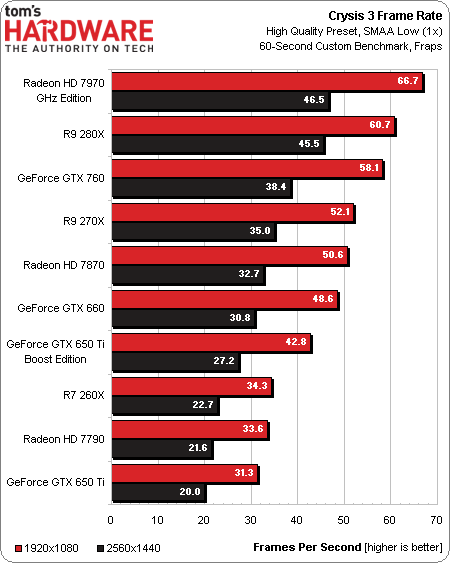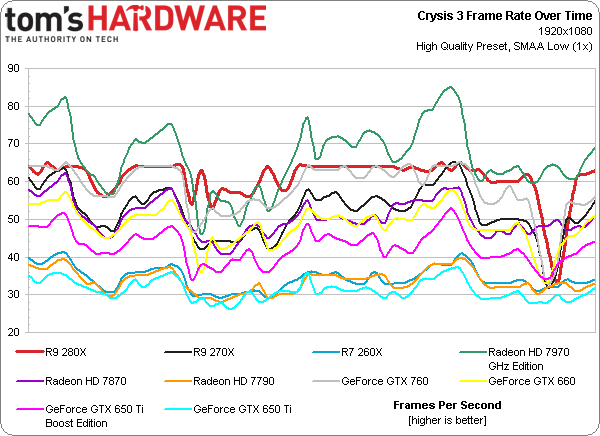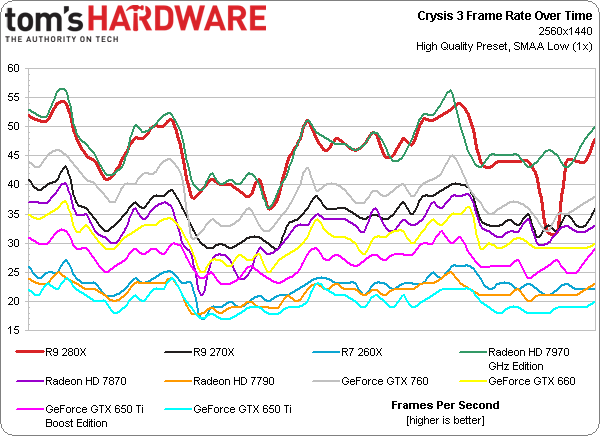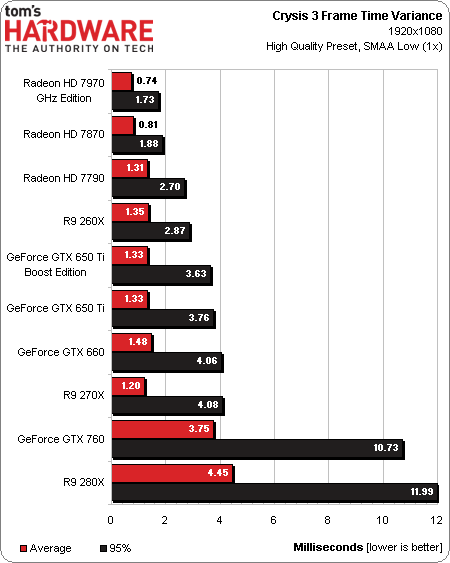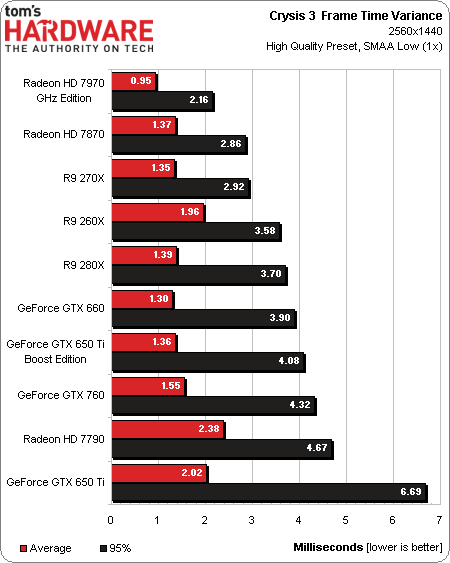AMD Radeon R9 280X, R9 270X, And R7 260X: Old GPUs, New Names
AMD is introducing a handful of new model names today, based on existing GPUs. Do the company's price adjustments make this introduction newsworthy, or will the excitement need to wait for its upcoming Radeon R9 290 and 290X, based on fresh silicon?
Results: Crysis 3
Nvidia's lack of a solution between $250 and $400 gives AMD an opportunity to enable playable frame rates in another demanding title at 2560x1440 with its R9 280X. GeForce GTX 760 dips close to 30 FPS, making it a better solution for cranking the details up even higher at 1920x1080.
You could also get away with a GeForce GTX 660 for $180 at that resolution instead of a R9 270X for $200. However, the smartest play is a Radeon HD 7870 for $180, as long as they're around.
At the lower end of the spectrum, Crysis 3 with a High System Setting preset is a little too demanding for R7 260X, Radeon HD 7790, or GeForce GTX 650 Ti. If this title is important to you, we again find ourselves drawn to the GeForce GTX 650 Ti Boost with 2 GB for an extra $10.
Unlike a lot of our more automated tests, Crysis 3 involves a manual run-through with live action that varies each time. As such, there’s a little more variance between benchmarks. This is most obvious from those dips you see at the very end of our 1920x1080 chart. There’s one area in the map we test that hammers frame rates. It clearly affects the R9 280X’s performance, but not the Radeon HD 7970 GHz Edition. Also not affected is the Radeon HD 7870, while the R9 270X slides down to about 30 FPS before popping right back up.
Throughout the run at 2560x1440, AMD’s fastest Tahiti-based card manages an almost-10 FPS lead over GeForce GTX 760. The Nvidia board is still plenty playable, but I’ll maintain that R9 280X is a good entry point for this resolution using the settings we’ve chosen.
Getting hammered by big performance dips at the end of our run really affects the worst-case frame time variance numbers reported by GeForce GTX 760 and R9 280X at 1920x1080. In reality, those shouldn’t worry you—the slow-down isn’t perceptible as we play through the test.
Get Tom's Hardware's best news and in-depth reviews, straight to your inbox.
-
CaptainTom Wow what's with the AMD hate? As it stands they are doing the same thing Nvidia did except without the outrageous prices. The GTX 770 wasn't a great deal when the 7970 was $50 cheaper. Have fun trying to run BF3 with 2GB of VRAM...Reply -
slomo4sho Nothing revolutionary but better prices I suppose.Reply
The MSI R9 280X Gaming at $299 appears to outperform the GTX 770 at 1600P and is within margin of error at 1080P according to Techpowerup. Not a bad value at $100 less and still overclocks well:
http://www.techpowerup.com/reviews/MSI/R9_280X_Gaming/26.html -
jimmysmitty So long story short, if you have a HD7970GHz then these do nothing for you.Reply
Best to hold out till the reviews on the R9-290X I guess. But considering the specs I hope for at least 20% performance increases over a 7970. -
Shankovich What happened to Chris? I didn't see this kind of hate with all of the 700 series rebrands. Also, to the Canadians here, grab the $270 7970 GHz edition cards while you still can.Reply -
BigMack70 I don't like this new strategy AMD and Nvidia are taking of rebranding an old series at improved price points and then releasing only one new chip at a stupidly expensive price point.Reply
Are the days of (nearly) annual simultaneous full line GPU launches from $100-500 with a dual GPU chip to follow at $750-1000 really over? -
cangelini Hate? The R9 280X won an *award*. I think Tahiti at $300 is pretty much brilliant.Reply
I wrote one of the least flattering GTX 780 stories out there. I only identified a couple of situations where a Titan made any sense at all. And although the 760 *did* change the balance at $250, that card still didn't get an award. I liked the 770 for the simple fact that it delivered better-than-680 performance for close to $100 less.
The rest of AMD's new line-up is a lot like what exists already. Again, the 7870 is a better value than 270X. So what are you getting worked up over? The fact that I'm pointing out these aren't new GPUs? They're not. ;) -
Shankovich Ok Chris, I agree with you, sorry for the over reaction. But I really don't like how nVidia made price increases for some of the rebrands. Looking forward to your 290 and 290X reviews :DReply -
ingtar33 i'll take a 7950 at $129 thank you very much (or two). There is a major retailer selling them for that this week. Best buy all year. two 7950s for the price of one r9-280x? yeah... i'll do that all day every day.Reply -
tomfreak Radeon 7790 has true Audio = but not enabled boooooo = as a 7790 owner I somewhat disappointed :( . Anyone have any idea if we can crossfire 1GB 7790 and 2GB 260x?Reply -
net_nakul By the time a R9 380X comes out, the GCN Tahiti XT achitecture may be 4 years old (assuming end of 2015). AMD better come up with an awesome new architecture by then, considering the R&D time they have.Reply
That goes to you too Mr. NVIDIA
